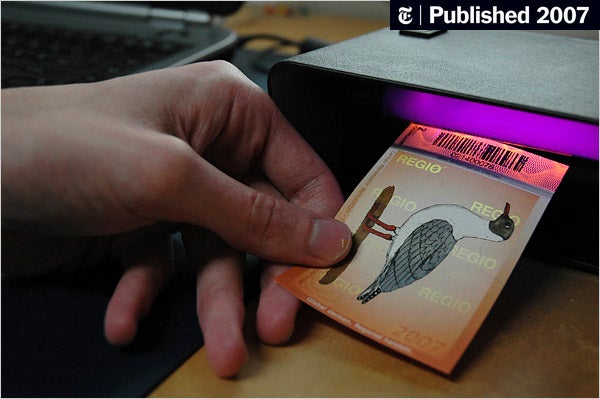
ROSENHEIM, Germany — Christian Gelleri, with his straightforward manner of speech, rumpled suit and home office, hardly resembles the polished central bankers whose every breath captivates financial markets. But just as Jean-Claude Trichet, president of the European Central Bank, lays claim to the title “Mr. Euro,” Mr. Gelleri can plausibly call himself “Mr. Chiemgauer.”
Mr. Gelleri runs an organization that issues an alternative currency, known as the chiemgauer, that consumers in the region southeast of Munich use to buy products as diverse as pizza, haircuts and rugs. Aimed at fostering the production and consumption of local products and services, the chiemgauer challenges the central banking orthodoxy that pumping more cash into an economy accelerates inflation and eventually harms growth.
“When people use the chiemgauer, the apple juice producer sells more bottles and the cheese maker sells more cheese,” Mr. Gelleri said. “In theory, this is not supposed to happen, but the fact is it does.”
While more than 300 million people in Europe use the euro to buy life’s essentials, a small but growing number concentrated in the German-speaking world use a proliferation of currencies with names like chiemgauer, urstromtaler, landmark, kirschblüte and kann was.
Issued by private organizations, these currencies are probably better understood as vouchers — pieces of paper that can be redeemed for goods and services at regional businesses that have agreed to accept them.
Charitable organizations sell the currencies for euros, at a profit, creating an incentive for people to obtain them. That, added to the desire to buy locally in an era of globalization, gives businesses that accept them a new vein of customers.
But they also typically include a feature aimed at jarring users into spending them. In the case of the chiemgauer, the notes lose 2 percent of their value each quarter unless spent.
Regiogeld, a German association for alternative currencies, tracks 21 such types of money in circulation in Germany, Austria and Switzerland, with an additional 31 in preparation. Gerhard Rösl, an economist with the University of Applied Sciences in Regensburg, Germany, has also located similar experiments in Denmark, Italy, Scotland, Spain and Italy.
According to the Bundesbank, the German central bank, these alternative currencies are legal, provided they do not resemble the euro. But they are not legal tender like the euro and are unlikely to challenge the official currency shared by 13 European nations.
Mr. Rösl recently published a paper estimating the value of the currencies in Germany at 200,000 euros, or $260,000, a drop compared to the trillions of euros in circulation.
The currencies are inspired by a German theoretician, Silvio Gesell, a socialist activist who died in 1930. He argued that money that sat in a bank was like dead weight on an economy, because it was accruing interest rather than being spent to fire consumption and production. Mr. Gesell proposed that money automatically depreciate over time — essentially hard-wiring inflation into the currency to generate an incentive to spend quickly.
The chiemgauer, named after the region around Rosenheim when it was created in 2003, follows this thinking.
To obtain chiemgauers, the roughly 1,000 users register with Mr. Gelleri’s organization and get what resembles an ordinary bank card. At about 40 sites around the region, they can draw chiemgauers at the rate of one per euro, and spend them at roughly 1,000 businesses.
The currency’s structure nurtures a psychology of spending to increase what economists call the “velocity of money.” That way, even though the total amount of money in circulation may not rise because euros get swapped for chiemgauers, the economic activity generated rises.
Alfred Licht owns a small family rug-weaving business in Rosenheim, and estimates he has accepted 8,000 to 10,000 chiemgauers over the last two years. He began accepting them as a way to lure customers who are interested in regional products. He spends them on medication, shoes and the occasional beer in a local tavern.
“I could hardly tell you how many I take in because I pass them on as fast as I can,” Mr. Licht said.
Mr. Gelleri, a 33-year-old former economics teacher, contends that the statistics bear out the anecdotes. While the euro money supply turns over about seven times a year, the supply of chiemgauers turns over at three times that rate.
Orthodox economists do not dispute that the chiemgauer’s velocity outstrips the euro’s, but they contend that people will logically draw fewer chiemgauers to protect themselves against the automatic devaluation.
“Yes, people spend the money more quickly,” Mr. Rösl said. “But this money is expensive, because it loses value, so people are bound to hold less of it than they would otherwise.”
But Jürgen Wemhöner, a retired retail manager who estimates he spends several hundred chiemgauers a month, said the currency’s appeal was that it supported the locals who accepted it. That seems to matter very much to people in Rosenheim.
“This currency gives small villages and regions a chance to survive,” Mr. Wemhöner said.



